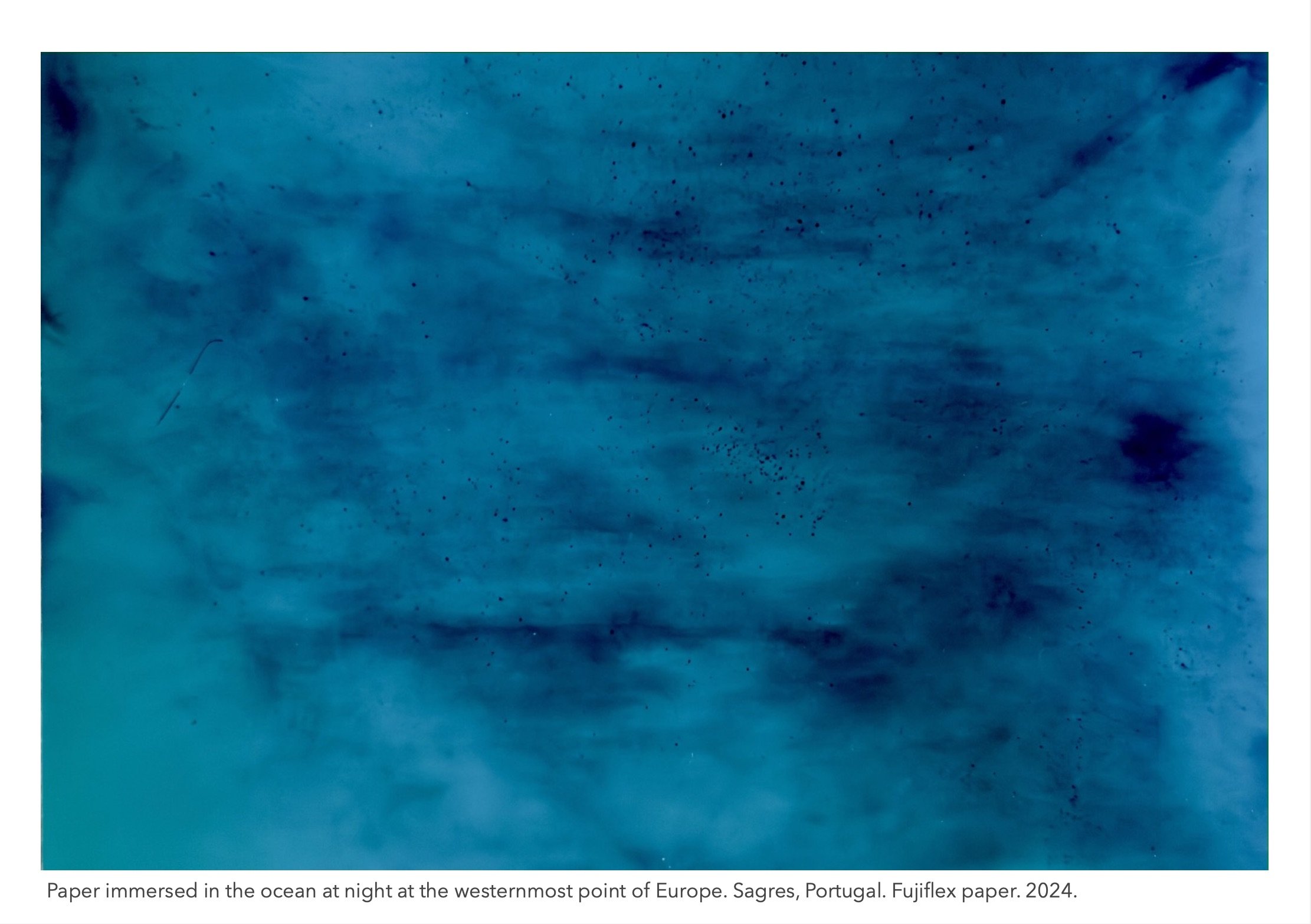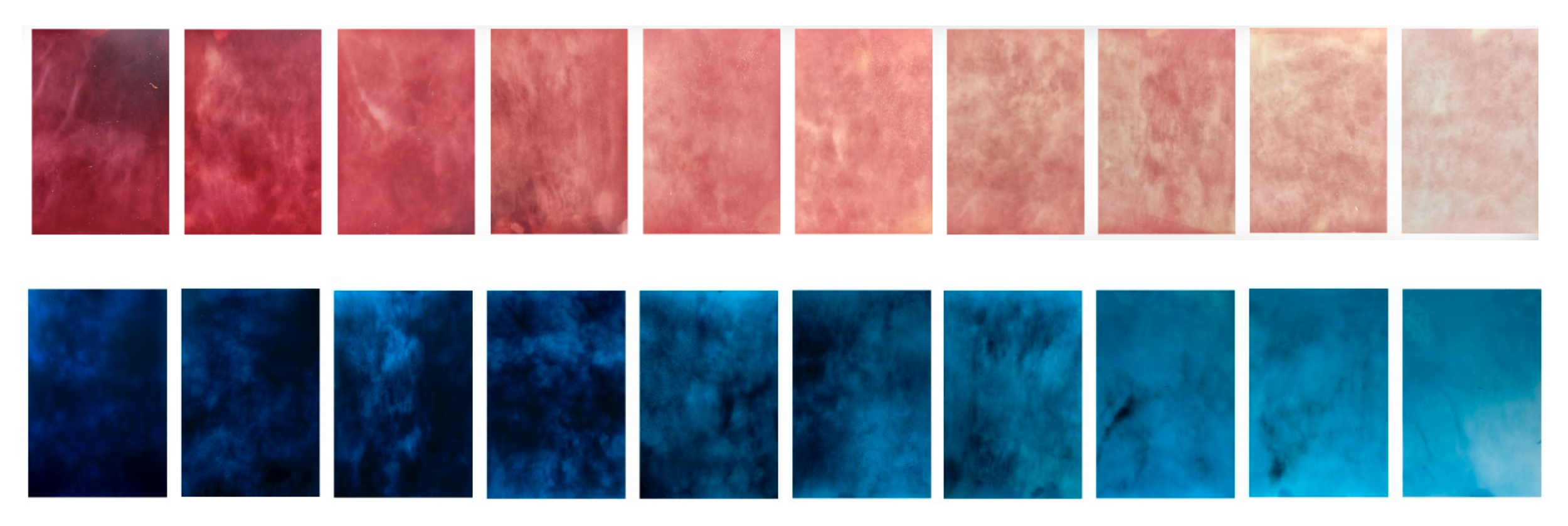As Fluid As A Woman
As Fluid as a Woman
Made without a camera, Belli’s photograms and sculptures are distilled
to the essential components of the photographic medium:
light, subject matter, and photo-sensitive paper or metal.
Stemming from her previous figurative work, already centered around the issues of identity and self-perception, opposing an internal word to all the external ones it is confronted with, this body of work of Federica Belli shifts the attention from the self-perception of human beings to the self-perception of other beings. Considering that our body is mainly composed of fluids, she tries to create a visual conversation between her bodily fluids and other biological fluids such as the ocean, the dew, the rain, and the fire. Employing the archaic technique of the photogram, she plunges photosensitive paper in all these organic fluids in order to create a sort of self-portrait for each of them. Without a camera or a negative, the paper is exposed directly to the moonlight, as the moon becomes the source of light for projecting on the paper everything that fluctuates in the fluid. In a way, the body of work becomes a circular portrait of fluidity in its widest sense, connecting various realms of nature in their impalpable essence.
“Ce qui nous unit n’est pas la peau, rigide et tendre, pas les mains, calleuses et vives, pas le sol que nous foulons chaque jour, pas la surface des choses que nous aimons tant caresser du bout des doigts en pensant la posséder, pas le vêtement qui nous alourdit, pas l’apparence qui nous colle, pas même l’image, l’idée fixe, l’étiquette, le nom, le titre. Ce qui nous unit se trouve ailleurs. Comme nous, liquide est le lien. L’humain est un animal océanique, possédant des courants, des marées, des éclipses, des vagues. Toutes sortes de fluides. Comme la terre habitée, ce qui nous unie se propage, perdure en mouvement, nous échappe et nous libère. Des fluides. Dans le nouveau versant de son oeuvre, Federica Belli traque le fluide à l’aide de la photographie. Paradoxalement, elle fige ce qui en elle, autour d’elle, coule, remue, bouscule, s’évapore pour mieux se réinventer. Ce travail est d’abord une recherche intime. Federica Belli photographie son sang, sa sueur, ses larmes — tous les fluides corporels qui, dans leurs sillages, la composent, l’arriment et la sculptent. Mais Federica Belli regarde aussi autour d’elle. Quête primordiale. De l’intime, elle passe à l’élément, à l’élémentaire : feu, mer, vent. Là aussi, du mouvement. Là encore, des fluides. La photographier, née dans le liquide amniotique d’une chambre noire utérine, s’empare du mouvement liquide. Federica Belli est là pour nous rappeler notre nature, océanique et vaste, mouvante et humide. Nous sommes, après tout, des êtres aqueux. Des gouttes qui coulent, trop brusquement, sur les joues du monde. Nous sommes salés. Nous sommes lacrymaux. Nous sommes fluides.”
Boris Bergmann
Through her sculptural experimentations with the archaic photographic technique of the photogram,
Belli explores the parallelisms and the distance between the natural fluids from our ecosystem
and the bodily fluids that make her human.
Installation at Musée Imaginaire. 2024.
Installation at Musée Imaginaire. 2024.
Installation at Musée Imaginaire. 2024.
The body of work, consisting of multiple series of photograms, is a natural prosecution of my previous research on self-perception through the language of the photographic self-portrait. After years spent investigating the écart between my perception and the one of the humans around me, I became curious about the perception of non-human substances that constitute our ecosystem. How could I try to imagine how it feels to be not someone else, but rather something else? The sheets of Fujiflex Color paper, physically immersed for some seconds in the most powerful – equally fascinating and terrifying – natural substances, and successively developed in the darkroom, brought me straight inside those substances I could not experience firsthand: the burning fire, the deep ocean at night, the underground. The result is a self-portrait of each substance which, in destroying the paper, also leaves its photographic mark. In the series, I am but a facilitator of self-portraits made by the substances I immerse the paper in.
Works
CHAPTER I: The Dream of the Blue Star
Immersed in the ocean water, exposed to the moonlight for just some seconds at night (the Fujiflex paper is extremely sensitive to the light), the photosensitive paper captures the light passing through the waves.
Each piece is a photogram exposed for the same amount of seconds to the moonlight, at regular intervals, from the middle of the night to the moment of the sunrise, thus capturing a self portrait of the ocean’s variability, capturing the sand, the algae and the medusae carried by the waves over the paper.
Each sheet of pink paper is the physical negative which has been exposed directly in the ocean, the blue is the positive obtained in the darkroom by contact.
What does the body of work consist of?
One series of 16 negatives (the actual paper I plunged in the ocean, in red) and 16 positives (the analogical transposition in the lab from negative to positive, in blue), both on Fujiflex Color Paper. 24x30cm.
One series of 10 negatives (the actual paper I plunged in the ocean, in red) and 10 positives (the analogical transposition in the lab from negative to positive, in blue), both on Fujiflex Color Paper. 24x30cm.
CHAPTER II: Piovean di Foco Dilatate Falde
Fire. Destruction and death, as much as light and survival. To humans, fire brings forward endless contradictions. Humans cannot survive fire, but how does the fire itself feel like, while it’s burning? We cannot know firsthand, due to the unbearable pain of the flames on our skin. Thus, I set the photosensitive paper on fire to photograph fire from within, capturing its self portrait. Crumbling between my hands, losing its straight form, somehow the paper records all the beauty and the power of fire as well.
What does the body of work consist of?
One series of 7 negatives (the actual paper I set on fire, in blue) and 7 positives (the analogical transposition in the lab from negative to positive, in red), both on Fujiflex Color Paper. 24x30cm.
Chapter III: Motherland
Sunlight is one of the fundamental elements for life on our planet. How is daylight filtered through the earth? How much light passes through the soil and reaches the roots of the plants around us? How is sunlight perceived by the earth itself and by the roots of the plants around us? In the first series, the sheets of photosensitive paper are placed at a 1 meter depth for a time ranging from one hour (on the left) to a maximum of five hours (on the right), to record the difference of sunlight perceived by the creatures at a depth of one meter underground. In the second series, I simulate the process of burial by gradually burying the paper in the soil.
What does the body of work consist of?
One series of 5 negatives (the actual paper I buried, going from white to pink) and 5 positives (the analogical transposition in the lab from negative to positive, going from black to green), both on Fujiflex Color Paper. 24x30cm.
One series of 3 negatives (the actual paper I buried, in black and light pink) and 3 positives (the analogical transposition in the lab from negative to positive, in black and greenish yellow), both on Fujiflex Color Paper. 24x30cm.
CLOSURE: As Fluid as a Woman
Back to my temple, back to my prison: my body. Here are all the fluids that make up a woman’s body. Each sheet of photosensitive paper is exposed to the sunlight through one of the biological liquids constituting my body. Blood, saliva, mucus, pee, sweat.
Once again, negatives and positives are coupled to highlight the complementary nature of the different photogram series making up the whole body of work.
What does the body of work consist of?
One series of 5 negatives (the actual paper I immersed in my bodily fluids, going from green to blue) and 5 positives (the analogical transposition in the lab from negative to positive, going from red to yellow), both on Fujiflex Color Paper. 24x30cm.












































